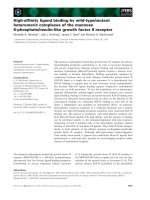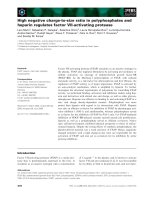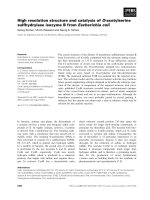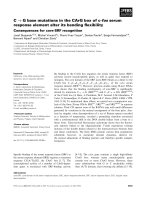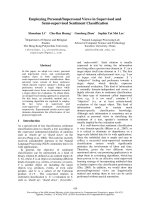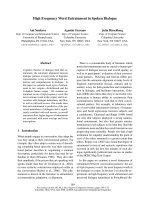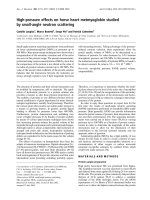Báo cáo khoa học: "High Serum Folate Values in Lambs Experimentally Infected with Anaplasma phagocytophilum" potx
Bạn đang xem bản rút gọn của tài liệu. Xem và tải ngay bản đầy đủ của tài liệu tại đây (60.26 KB, 4 trang )
Acta vet. scand. vol. 44 no. 3-4, 2003
Folates are involved in nucleic acid, protein and
amino acid synthesis. In human serum, it has
been estimated that 60% to 70% of folates are
bound to proteins (Wagner 1985). Folate bind-
ing proteins (FBPs) are therefore crucial to the
assimilation, distribution and retention of the
vitamin folic acid and have been identified in
various cells, extracellular fluids and tissues
from humans and several animal species. FBPs
have different functions based on their bio-
chemical properties and can be divided into 3
classes: high-affinity folate binding proteins
(HFBP), membrane-associated folate-binding
proteins, which function in the transport of fo-
late compounds across cell membranes, and cy-
toplasmic-binding proteins with a high affinity
for specific reduced-folate compounds (Hen-
derson 1990).
Tick-borne fever (TBF) caused by the rickettsia
Anaplasma phagocytophilum (formerly Ehr-
lichia phagocytophila) is a common disease in
domestic ruminants on Ixodes ricinus infested
pastures in Norway (Stuen 1997, Stuen & Berg-
ström 2001). During the acute infection, A.
phagocytophilum are found in cytoplasmatic
inclusions in blood leucocytes, mainly neu-
trophils. Up to 95% of the neutrophils can be
infected. The rickettsemia is followed by a se-
vere neutropenia lasting for 1-2 weeks (Foggie
1951, Woldehiwet & Scott 1993).
The reason for this neutropenia is not known,
but may be due to destruction and removing of
infected cells (Hudson 1950, Woldehiwet 1983,
Rikihisa 1991).
Neutropenia in the peripheral blood of lambs is
seldom observed except for lambs infected with
A. phagocytophilum. Recently, during a trace
element deficiency study in Norway, some
lambs grazing on I. ricinus infested pastures
had both a severe neutropenia (<0.7x10
9
cells/l)
and increased serum folate values up to 901.2
nmol/l (Kleppa, unpublished result). In con-
trast, the normal range of serum folate concen-
tration in sheep has been estimated to vary from
3.2 to 6.6 nmol/l (Branda 1981). Unfortunately,
EDTA-blood was not available for A. phagocy-
tophilum examination. The aim of the present
study was therefore to evaluate the variation in
serum folate concentration in lambs experi-
mentally infected with A. phagocytophilum.
Eight lambs, 4 to 5 months old, of the Dala and
Rygja breeds were used. All lambs were kept
indoors from birth and throughout the whole
experimental period. The lambs were fed hay,
silage and concentrates. Four lambs were inoc-
ulated intravenously on day 0 with 1 ml of a
whole blood dimethyl sulphoxide stabilate of
an ovine A. phagocytophilum variant. Sequenc-
ing result of the 16S rDNA gene of this variant
was found identical with the DNA sequence of
Acta vet. scand. 2003, 44, 199-202.
High Serum Folate Values in Lambs Experimentally
Infected with Anaplasma phagocytophilum
By K. E. Kleppa and S. Stuen
Department of Sheep and Goat Research, Norwegian School of Veterinary Science, Sandnes, Norway.
Brief Communication
GenBank accession number M73220. The sta-
bilate contained 1.3x10
6
A. phagocytophilum
infected cells/ml. The 4 four lambs were left as
uninfected controls. The infected lambs were
followed for 42 days, while the controls were
followed for 21 days. Rectal temperatures were
measured daily. The incubation period was de-
fined as the period between inoculation and the
first day of fever (≥40.0°C). The duration of
fever was calculated as the number of days with
elevated body temperature (≥ 40.0 °C) (Wolde-
hiwet & Scott 1982).
Blood was collected in plain and EDTA- vacu-
tainers (Venoject
®
, Terumo Europe) from all
lambs on days 0, 1- 4, 6, 7, 8, 10, 12, 14, 16, 18
and 21. In addition, samples from the A. phago-
cytophilum infected lambs were collected on
days 24, 28, 35 and 42. Blood samples collected
in EDTA were analysed electronically (Techni-
con H1
®
, Miles Inc., USA) and haematological
values including total and differential leukocyte
counts were recorded. Blood smears were
made, and stained with May-Grünwald Giem-
sa. Four hundred neutrophils were examined on
each smear and the percentage of A. phagocy-
tophilum infected neutrophils was calculated.
Whole blood samples were centrifuged within
one hour, and sera were stored at ÷20°C and
later analysed for vitamin B
12
and folate by
Solid Phase No Boil Dualcount
®
kit (DPC) (Di-
agnostic Products Corporation, LA). As a qual-
ity control, 21 of the samples from both inocu-
lated and control lambs were analysed in
parallel by use of AutoDELFIA
TM
Folate
®
kit
(Time-resolved fluoroimmunoassay kit B072-
101) at the Division of Clinical Chemistry,
Central Hospital in Rogaland, Norway.
Student´s 2 samples t-test and a linear regres-
sion analysis were used in statistical calcula-
tions (Software program JMP, version 3.1.6.2,
SAS Institute).
All 4 A. phagocytophilum inoculated lambs re-
acted with high fever 3 to 4 days after inocula-
tion (mean: 3.3 ± 0.43 days). Maximum tem-
perature recorded in all lambs varied from 41.8
to 42.0°C (mean: 41.95 ± 0.087 °C), and the du-
ration of fever varied from 7 to 14 days (mean:
9.8 ± 2.68 days). The appetite in the infected
lambs was generally depressed for 1 to 4 days
during the fever period. In contrast, none of the
controls developed fever or other clinical signs.
A. phagocytophilum inoculated lambs reacted
with neutropenia from day 10 to day 18. In this
period, the absolute number of neutrophils in
infected and contol lambs varied from 0.24 to
1.08x10
9
and 1.70 to 3.18x10
9
cells/l, respec-
200 K. E. Kleppa et al.
Acta vet. scand. vol. 44 no. 3-4, 2003
Figure 1. Percentage of
infected neutrophils (mean
+ SD) in 4 lambs inoculated
with A. phagocytophilum
infected blood on day 0 and
followed for 42 days. The
percentage was less than
1% on days 2, 14, 24, 28
and 42
* one lamb was found in-
fected; not the same
lamb each time
** two lambs were found
infected
tively. The absolute number of neutrophils in
these 2 lamb groups were significant different
from day 8 to day 18 (p<0.01).
Inclusions in neutrophils (rickettsaemia) were
first seen on days 2 and 3 in inoculated lambs
(Fig. 1). The highest percentage of infected
neutrophils was seen on day 4 in the inoculated
lambs (mean: 51.3% ± 2.87%). Inclusions were
not found in blood from the controls.
The median of 21 folate values analysed with
the DPC assay system and the AutoDELFIA
method was 4.4 and 4.5 nmol/l, respectively.
The mean folate values measured by these 2
methods were not significantly different
(p>0.05).
Mean serum folate concentration increased
from day 4 in all infected lambs, except for an
increased value (39.6 nmol/l) in one lamb on
day 3, with a peak on day 10 (mean: 414.3 ±
130.2 nmol/l) (Fig. 2). In contrast, the mean
serum folate concentration in the controls var-
ied from 4.3 to 6.9 nmol/l. The mean folate val-
ues in A. phagocytophilum infected lambs were
significantly different from the corresponding
values in the control lambs from day 4 to day 12
(p<0.05).
Rickettsaemia and increased serum folate con-
centration were observed in all infected lambs
from day 4 to day 14. Before and after this pe-
riod, A. phagocytophilum infection was found
in 5 of 8 samples in lambs with increased serum
folate values marked with asterisks in Fig. 2.
The serum vitamin B
12
concentration was
above 300 pmol/l in both A. phagocytophilum
infected and control lambs, and no significant
difference between the 2 lamb groups was ob-
served.
All inoculated lambs showed clinical signs con-
sistent with a typical A. phagocytophilum infec-
tion (Foggie 1951, Woldehiwet & Scott 1993).
Rickettsaemia were seen in all infected lambs
on day 3, while the increase in serum folate
concentration was observed on the following
day. An exception, one lamb found infected on
day 2 had already a high serum folate value the
next day. Similarly, the observed rickettsaemia
and high serum folate values lasted for around
9 and 10 days, respectively. The second and
third peak of serum folate concentration was
also observed in the same period when relapses
of rickettsaemia were seen in blood smears, al-
though not all lambs with detectable rick-
ettsaemia had an increased serum folate con-
centration on the same day. This may be due to
delay in serum folate response compared with
blood rickettsaemia, as observed on days 2, 3
and 4. A direct day-by-day comparison of these
two parameters may therefore be difficult. A re-
gression analysis did not show a linear relation-
ship (p>0.05).
Rickettsaemia is normally followed by neu-
tropenia in A. phagocytophilum infected lambs
(Foggie 1951). As mentioned earlier, the reason
for this neutropenia may be due to destruction
and removing of infected cells (Hudson 1950,
Woldehiwet 1983, Rikihisa 1991). The high
serum folate values in A. phagocytophilum in-
fected lambs may therefore be caused by leak-
High serum folate values in lambs 201
Acta vet. scand. vol. 44 no. 3-4, 2003
Figure 2. Mean (+ SD) serum
folate concentration (nmol/l) in
4 A. phagocytophilum infected
lambs
* increased value in one lamb;
not the same lamb each time
** increased values in 2 lambs
*** increased values in 3 lambs
age of soluble and membrane-bound folate
from neutrophils. This assumption is supported
by the observation that soluble FBPs have been
identified in specific granules of human neu-
trophils. These granules are released during
phagocytosis and may play a role in the control
of an infection (Colman & Herbert 1980).
However, this theory has to be further investi-
gated.
Changes in folic acid metabolism in vitamin
B
12
deficient sheep have been reported (Gaw-
thorne & Smith 1974), but in the present study
the serum vitamin B
12
concentration was con-
sidered to be within normal variation (Suttle
1986).
Mantzos et al. (1974) examined the occurrence
of specific binders of folic acid with high bind-
ing capacity in plasma from 16 healthy sheep
and found only one sheep positive. This result
indicates that HFBF are not normally present in
the blood of sheep. Unfortunately, no further in-
formation about the sheep was available, since
the blood samples were obtained from a slaugh-
terhouse. In order to analyse the origin of the
high serum folate concentration, it is necessary
to know the exact nature of the folate compo-
nents (Wagner 1985, Henderson 1990).
In conclusion, the present report is the first de-
scription of high serum folate concentration in
experimentally A. phagocytophilum infected
lambs. The present study indicates that A.
phagocytophilum infected sheep can be used as
a model in the study of soluble FBPs from neu-
trophils. However, the mechanism behind the
elevated serum folate concentration in A.
phagocytophilum infected lambs and the class
of FBP involved have to be further investigated.
References
Branda RF: Transport of 5-methyltetrahydrofolic
acid erythrocytes from various mammalian
species. J. Nutr. 1981, 111, 618-623.
Colman N, Herbert V: Folate-binding proteins. Ann.
Rev. Med. 1980, 31, 433-439.
Foggie A: Studies on the infectious agent of tick-
borne fever in sheep. J. Path. Bact. 1951, 63, 1-
15.
Gawthorne JM, Smith RM: Folic acid metabolism in
vitamin B12-deficient sheep. Biochem. J. 1974,
142, 119-126.
Henderson GB: Folate binding proteins. Ann. Rev.
Nutr. 1990, 10, 319-335.
Hudson JR: The recognition of tick-borne fever as a
disease in cattle. Brit. vet. J. 1950, 106, 3-17.
Mantzos JD, Alevizou-Terzaki V, Gyftaki E: Folate
binding in animal plasma. Acta haematol. 1974,
51, 204-210.
Rikihisa Y: The tribe Ehrlichieae and ehrlichial dis-
eases. Clin. Microbiol. Rev. 1991, 4, 286-308.
Stuen S: Utbredelsen av sjodogg (tick-borne fever) i
Norge. (The distribution of tick-borne fever
(TBF) in Norway. Norsk vet. T. 1997, 109, 83-87.
Stuen S, Bergström K: Serological investigation of
granulocytic Ehrlichia infection in sheep in Nor-
way. Acta vet. scand. 2001, 42, 331-338.
Suttle NF: Problems in the diagnosis and anticipation
of trace element deficiencies in grazing livestock.
Vet. Rec. 1986, 119, 148-152.
Wagner C: Folate-binding proteins. Nutr. Rev. 1985,
43, 293-299.
Woldehiwet Z: Tick-borne fever: A review. Vet. Res.
Comm. 1983, 6, 163-175.
Woldehiwet Z, Scott GR: Immunological studies on
tick-borne fever in sheep. J. comp. Path. 1982,
92, 457-467.
Woldehiwet Z, Scott GR: Tick-borne (pasture) fever.
In: Woldehiwet Z, Ristic M. (eds.) Rickettsial and
chlamydial diseases of domestic animals, Perga-
mon Press, Oxford, 1993, 233-254.
202 K. E. Kleppa et al.
Acta vet. scand. vol. 44 no. 3-4, 2003
(Received August 20, 2003; accepted September 1, 2003).
Reprints may be obtained from: S. Stuen, Norwegian School of Veterinary Science, Kyrkjev. 332/334, N-4325
Sandnes, Norway. E-mail: , tel: +47 51 60 35 10, fax: +47 51 60 35 09.
